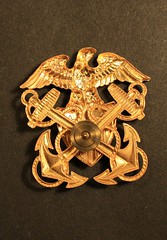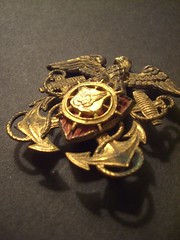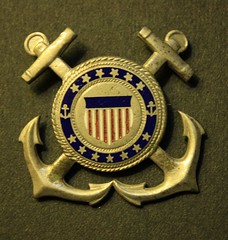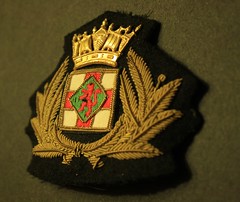Three piece construction.
Stamped gold metal, red enamel on shield.
No hallmark.
Circa Second World War era.
In the post immediately preceding this one, I detailed several variations of the U.S. Army Transportation Corps, Water Division (USATC-WD) hat badge. Here, I present two additional examples of the hat badge, a fake, collar brass, shoulder boards and a cuff device.
It may be worth noting that much of the collar insignia worn and organization aboard today's Military Sealift Command ships may be traced to the hazy and hurried period which saw the birth of USATC-WD. In the late 1940s (which reached its culmination in 1954), the USATC-WD was collapsed into its Navy analog and became the Military Sea Transportation Service; and a decade and a half later was renamed the Military Sealift Command. Most of the varied nautical customs and courtesies followed by USATC-WD personnel - they being old-salts or sea dogs at the tail end long of windjammer sailor traditions - as observed by troops and war brides ferried from overseas stateside, have fallen by the wayside. Today's MSC technocrats, contract crews, and unionmen have a rich past to consider, if they so choose.
Hat Badges
USATC-WD, Hat badge, obverse.

Shield with red enamel on alternating stripes variation.
USATC-WD, Hat badge, obverse detail.

USATC-WD, Hat badge, reverse.

USATC-WD, Hat badge, reverse detail.

USATC-WD, Hat badge, obverse.

Plain shield with no enamel variation.
USATC-WD, Hat badge, obverse detail.

USATC-WD, Hat badge, reverse.

USATC-WD, Hat badge, obverse.

Plain shield with no enamel variation.
This specific hat badge is on display at the U.S. Merchant Marine Academy museum. It is in a shadowbox with an array of other hat badges worn by U.S. Merchant Marine Academy graduates. Among the other devices shown are U.S. Maritime Service commissioned and warrant officer, U.S. Army Corps of Engineers Floating Plant personnel, and Grace Lines. This badge appears to be a Pasquale badge, bringing to mind that these devices were crafted with expedience at the end of the Second World War. I suspect more care in regard to their detail came about in post-war years.
USATC-WD, Fake Hat badge, obverse.

This is a fake hat badge. During the Second World War, it appears that only Meyer and Gemsco eagles were used, with Vanguard-designed eagles being kept out of the fray. Perhaps maybe a Korean War-era Vanguard eagle such as this may have been defaced to create a TC-WD device; at least one is known to exist in the collection of Dave Collar. One means to determine a fake is to remove the TC device (if affixed with prongs) and look for an IOH (Institute of Heraldry) mark on the reverse. An easier determiner would be to look for the IOH number. For example, V-12 was used by Vanguard Industries beginning in 1965, with V-12-N after 1974 to denote a "Navy Approved" device. The TC-WD was long dissolved by this time.
Collar Brass
USATC-WD, Junior 3rd Officer collar brass
Despite the fact that the USATC-WD was a military organization, it was comprised of civilians, and as such they held traditional marine positions and titles. As follows is relative Army Rank and Marine title by department:
Deck
Colonel ... Master
Lt. Col ... Chief Officer
Major ... 1st Officer
Captain ... 2nd Officer
1st Lt ... 3rd Officer
2nd Lt ... Jr 3rd Officer
Engine
Colonel ... Chief Engineer
Lt. Col ... Staff Engineer
Major ... 1st Asst Engineer
Captain ... 2nd Asst Engineer
1st Lt ... 3rd Asst Engineer
2nd Lt ... Jr 3rd Asst Engineer
Steward
Major ... Chief Steward
Captain ... 2nd Steward
1st Lt ... 3rd Steward
Agent
Major ... Ship Transportation Agent
1st Lt ... Ship Transportation Clerk
2nd Lt ... Asst Ship Transportation Clerk

USATC-WD, 3rd Officer collar brass


USATC-WD, Chief Officer collar brass


USATC-WD, Master collar brass



Shoulder Boards
USATC-WD, Junior Officer shoulder boards

I would tentatively say that this set of shoulder boards would belong to a 3rd Officer; even though post-war regulations do not have such a board in the rank tables. Once again, for expediency's sake, it is highly probable that the ½-stripe board was not available (these were not commonly manufactured items), and the closest corresponding board to a USATC-WD 3rd Officer in the other marine services would have been Lieutenant (Junior Grade); hence the incongruous Lt (jg.) board.
Do note also that the boards have an applied U.S. Army Transportation Corps device as opposed to a woven device. The buttons are of late war U.S. Maritime Service vintage.
Rank stripes on cuffs and shoulder boards somewhat followed the relative rank structure found in the other sea services.
Deck
Master ... 4 stripes
Chief Officer ... 3½
1st Officer ... 3
2nd Officer ... 2
3rd Officer ... 1
Jr 3rd Officer ... ½
Engine
Chief Engineer ... 4
Staff Engineer ... 3½
1st Asst Engineer ... 3
2nd Asst Engineer ... 2
3rd Asst Engineer ... 1
Jr 3rd Asst Engineer ... ½
Steward
Chief Steward ... 3
2nd Steward ... 2
3rd Steward ... 1
Agent
Ship Transportation Agent ... 3
Ship Transportation Clerk ... 1
Asst Ship Transportation Clerk ... ½


USATC-WD, 3rd Officer shoulder boards

Note the applied cuff device to the board. This device was used in place of the U.S. Navy officer and staff corps devices, specifying USATC-WD officer status; many of the marine services adopted some variation of U.S. Navy officer and enlisted uniforms, merely substituting buttons or devices for USN ones. Interestingly, the USATC-WD did not have its own specific button made; instead, USN and "Merchant Marine" buttons were used.



Cuff Device
USATC-WD, Officer cuff device







































